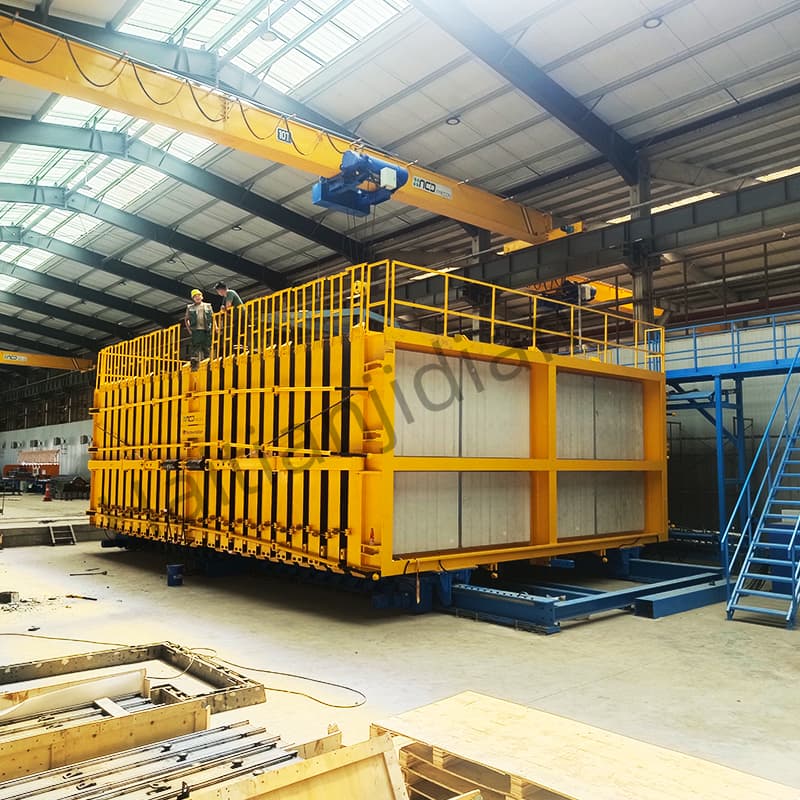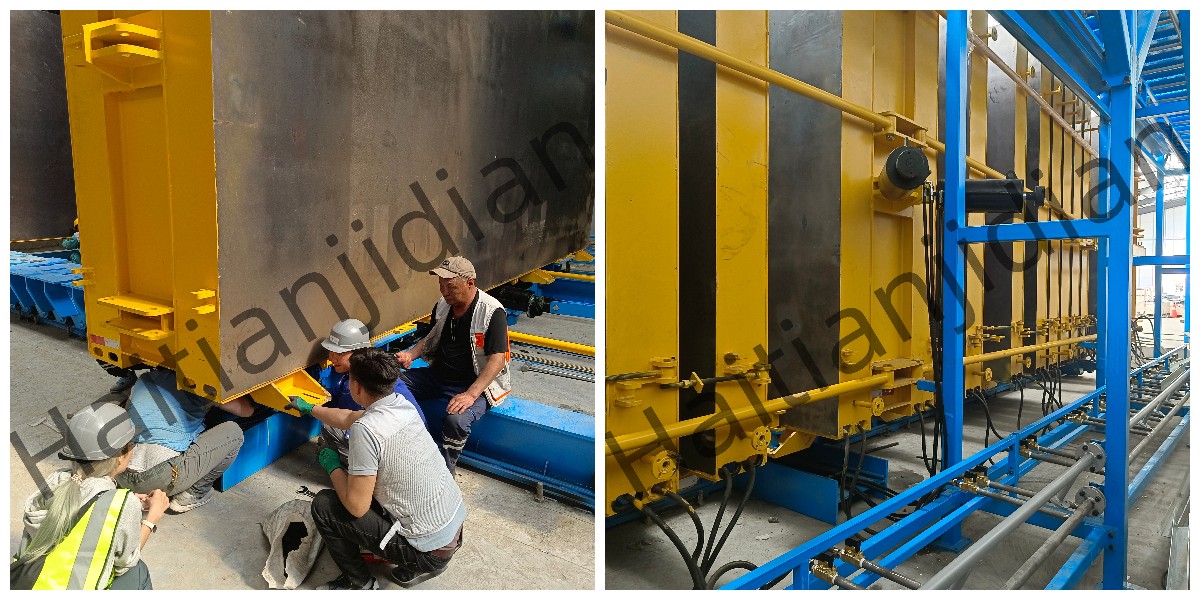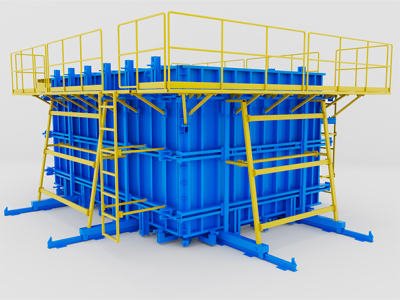Prefabricated Concrete Battery Mold
The Texas Haitian Mechanical and Electrical Company adopts the "slot assembly mold (Pocket Battery)" technology as its core, which has remarkable advantages.
1、 the mold cavity has strong adjustability, allowing for independent pouring of multiple slots, which can flexibly adapt to the production of different components such as prefabricated wall panels and drainage channels, reducing mold replacement costs.
2、 it is equipped with an automatic mold opening and closing system, with high precision linkage, significantly shortening the demolding cycle, and increasing production efficiency by more than 30% compared to traditional equipment.
3、 the technology originates from the German BT-Innovation Butterfly Battery® system, combined with domestic working conditions, the component forming error is controlled within ±1mm, meeting the requirements of high-precision construction.
4、 it fully complies with the T/CCMA 0109-2020 standard, can be included in the promotion system of prefabricated technology by the Ministry of Housing and Urban-Rural Development, is suitable for large-scale prefabricated component production scenarios, and has both practicality and compliance.
Pre-cast concrete-related products are providing efficient solutions for the construction and new energy sectors. The large-scale pre-cast concrete formwork structures are stable and have strong load-bearing capacity, suitable for the pouring of various large components, which can reduce on-site construction processes and significantly shorten the project cycle. The pre-cast concrete battery molds focus on precision control and can precisely ensure the forming quality of battery-related components, and are resistant to concrete corrosion, providing reliable support for the construction of new energy energy storage facilities.
The large-scale pre-cast concrete formwork molds support customized development and can be flexibly adjusted according to different engineering parameters to help achieve standardized production. The patterned wall shelves have both practicality and decorative properties. The clear texture can enrich the spatial hierarchy and are widely used in home decoration and commercial spaces for wall decoration, meeting both functional and aesthetic requirements.
High adjustability of cavity: The group formwork (slot assembly mold) is suitable for multiple types of components, significantly reducing mold change costs.
Traditional group formwork equipment generally has the limitation of "fixed cavity and single category" - if it is necessary to switch the production of different types of components such as prefabricated wall panels and drainage channels, the entire mold often needs to be disassembled and replaced, which not only takes a long time (traditional mold change takes 8-12 hours), requires a lot of effort (6-8 people need to cooperate), but also requires enterprises to invest in multiple sets of dedicated molds, resulting in high equipment and labor costs. However, the group formwork (pocket battery mold) of Texas Haiti Electromechanical Company, through the innovative structure of "modular cavity design + independent slot control", fundamentally breaks this limitation.
The mold cavity of this group formwork is divided into multiple independent slots, and the parameters of each slot's size (height, width, length) and shape (rectangular, arc-shaped, irregular) can be independently controlled through the fine adjustment of modular components. Different component production requirements can be met without the need to replace the entire mold. For example, in the production of prefabricated wall panels, the group formwork (slot assembly mold) can adjust the slot height (to adapt to wall panels of different thicknesses from 100mm to 300mm) and width (to adapt to wall panels of different widths from 1.2m to 2.4m), and each slot can pour concrete independently and simultaneously, avoiding the problem of "one slot failure, the entire mold stops" in traditional molds. When switching to the production of drainage channels, only the arc-shaped modules in the slots need to be replaced and the cross-sectional dimensions adjusted, and the mold change can be completed in 2-3 hours, reducing the mold change time by more than 70% compared to traditional equipment and directly lowering the mold replacement cost by 60%. This "multi-functionality in one mold" flexibility not only meets the demand for diversified component categories in construction projects (such as the need for wall panels, drainage channels, and decorative components in the same project), but also allows small and medium-sized prefabricated component enterprises to avoid investing in multiple sets of dedicated molds, effectively lowering the production threshold and improving the comprehensive utilization rate of equipment.
Automatic opening and closing mold system: The group formwork (pocket battery mold) improves the linkage precision and production efficiency, exceeding traditional equipment by 30%.
"Long demolding cycle and frequent manual intervention" are the core bottlenecks restricting the production efficiency of traditional group formwork. Traditional equipment relies on manual operation of the hydraulic system to complete the opening and closing of the mold, which not only easily leads to component surface damage and demolding difficulties due to manual operation errors (such as uneven opening and closing speeds and position deviations), but also results in a single demolding cycle of 120-150 minutes, with a daily production capacity of only about 50 pieces per production line, making it difficult to meet the delivery requirements of large-scale projects. The "high-precision automatic opening and closing mold system" equipped on the group mold (slot assembly mold) has completely changed this situation through an intelligent design of "servo motor + PLC linkage control". This system is driven by imported German servo motors and is equipped with high-precision sensors to provide real-time feedback on position information, ensuring that the position accuracy of the opening and closing mold action is controlled within ±0.5 millimeters, guaranteeing that all parts of the mold move synchronously and evenly stressed, and avoiding component scrapping due to mechanical deviation. At the same time, the system is fully integrated with the concrete pouring and component curing processes, and can automatically trigger the opening and closing mold action based on the component forming time (monitored by temperature sensors for concrete solidification), without the need for manual intervention. In actual production, the single demolding cycle of the group mold (pocket battery mold) has been shortened from the traditional 120 minutes to within 80 minutes. Combined with the advantage of multi-slot synchronous production, the daily production capacity of a single production line has increased from 50 pieces to over 65 pieces, significantly improving production efficiency by 30% compared to traditional equipment. In addition, the automation operation has reduced the labor requirement from 6 people per shift to 2 people per shift, reducing labor costs by 67%, and the component scrapping rate has been controlled below 2% from the traditional 5%, further enhancing production efficiency.
Localization of German Technology: The group mold (slot assembly mold) controls the error within ±1 millimeter, meeting high-precision construction requirements
The precision of prefabricated components directly determines the adaptability of on-site construction and the quality of the building - if the wall panel joint error exceeds 2 millimeters, a large amount of grinding and repair work is required later; if the cross-section error of the drainage channel is too large, it may lead to water accumulation and leakage. Traditional group molds are limited by technical levels, and the component forming error is generally above ±3 millimeters, making it difficult to meet the requirements of high-precision construction. The technology of the group mold (pocket battery mold) originates from the German BT-Innovation Butterfly Battery® system (a high-precision benchmark technology in the European prefabricated equipment field), and has been optimized for domestic working conditions, ultimately strictly controlling the forming error within ±1 millimeter, reaching the industry-leading level.
Although the original German technology has the advantage of high precision, it needs to be adapted to the local concrete mix ratio (low grade, high fluidity) and production environment (constant temperature and humidity) in Europe. Direct introduction to China may lead to problems such as "uneven concrete solidification and cavity fitting deviation". Therefore, Texas Haidi Electromechanical Company has made two key optimizations to the mold: first, adjusting the cavity cooling structure, by installing a temperature control module to adapt to the solidification characteristics of domestic high-grade concrete (C30-C50), avoiding component shrinkage deviation due to temperature differences; second, optimizing the concrete flow channel, using an arc-shaped diversion design to reduce air bubble residues during concrete pouring, ensuring the density and dimensional accuracy of the component. In actual application, the prefabricated wall panels produced by the group mold (slot assembly mold) have joint errors controlled within 1 millimeter, allowing for direct "seamless splicing", reducing the later adjustment process by 40%; the cross-sectional arc error of the produced drainage channels is ≤0.8 millimeters, and the drainage slope precisely meets the standards, completely solving the leakage problems caused by insufficient precision of traditional components, providing a reliable guarantee for high-precision construction.
Comprehensive Compliance: The group mold (pocket battery mold) meets industry standards and is included in the promotion system of the Ministry of Housing and Urban-Rural Development
With the standardized development of the prefabricated component industry, equipment compliance and large-scale adaptability have become the core considerations for enterprise selection - equipment that does not meet industry standards not only cannot participate in the bidding of key projects but may also face production suspension risks due to safety and environmental protection issues. Group assembly molds (slot assembly molds) are guided by high standards from the R&D stage, not only fully complying with the T/CCMA 0109-2020 "Technical Requirements for Prefabricated Concrete Component Production Equipment", but also successfully incorporated into the prefabrication technology promotion system of the Ministry of Housing and Urban-Rural Development, demonstrating both practicality and compliance.
The T/CCMA 0109-2020 standard imposes strict requirements on the safety protection, precision control, and environmental emissions of prefabricated equipment: for instance, the operating noise of the equipment must be ≤ 85 decibels, the hydraulic oil leakage rate ≤ 0.1L/h, and the forming precision of components ≤ ±2 millimeters. Group assembly molds (pocket battery molds) have met these standards by installing safety light curtains (to prevent accidental contact), optimizing the sealing structure of the hydraulic system (to reduce leakage), and upgrading the precision monitoring module (to control errors within ±1 millimeter). Moreover, after being included in the promotion system of the Ministry of Housing and Urban-Rural Development, enterprises using this equipment can have priority in participating in national prefabricated building demonstration projects and enjoy technical certifications and policy subsidies. In large-scale production scenarios, group assembly molds (slot assembly molds) can be seamlessly integrated with concrete mixing systems and automated curing kilns to form a full-process production line, with a daily production capacity of over 100 pieces per line. The precision fluctuation of 1,000 consecutive components does not exceed 0.5 millimeters, fully meeting the production demands of large-scale prefabricated component projects such as affordable housing, municipal roads, and large venues, achieving "compliant production and efficient delivery".
Conclusion: Group assembly molds (slot assembly molds / pocket battery molds) - the core driving force for the upgrade of the prefabricated component industry
From solving the pain points of multi-category production with "adjustable cavities" to improving efficiency with "automatic mold opening and closing", from ensuring precision with "German localization" to adapting to large-scale promotion with "all-round compliance", the group assembly molds (slot assembly molds / pocket battery molds) technology of Texas Haidi Electromechanical Company, with its characteristics of "full-scenario adaptability, full-process intelligence, and full-standard compliance", has redefined the performance benchmark of prefabricated component production equipment. This technology not only reduces production costs and enhances competitiveness for enterprises but also promotes the transformation of the prefabricated component industry from "extensive production" to "refined, efficient, and standardized". With the continuous expansion of the prefabricated building market, group assembly molds (pocket battery molds) are expected to become the core equipment for more prefabricated component enterprises, injecting stronger impetus into the development of China's building industrialization and facilitating the realization of the industry goal of "green buildings and efficient construction".






